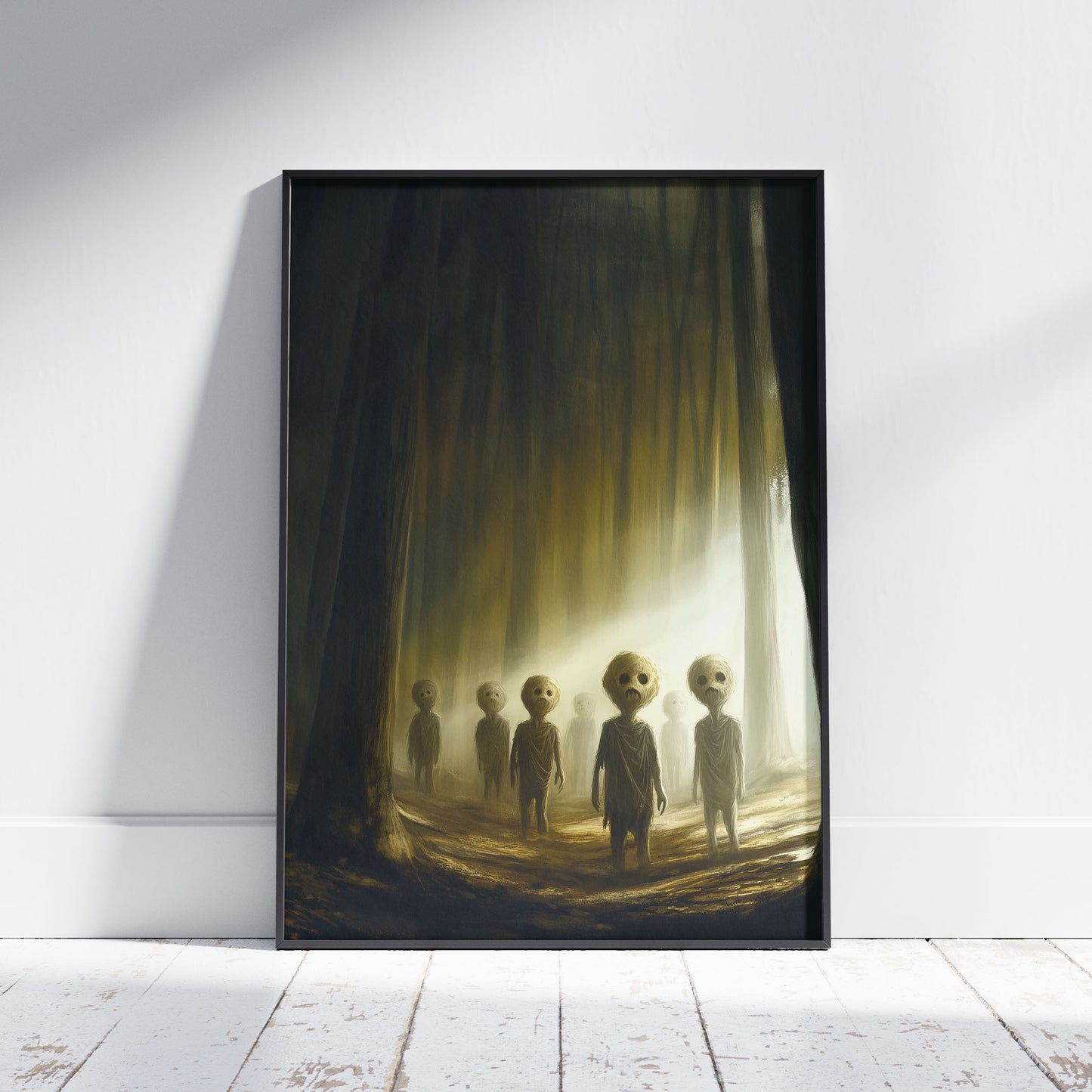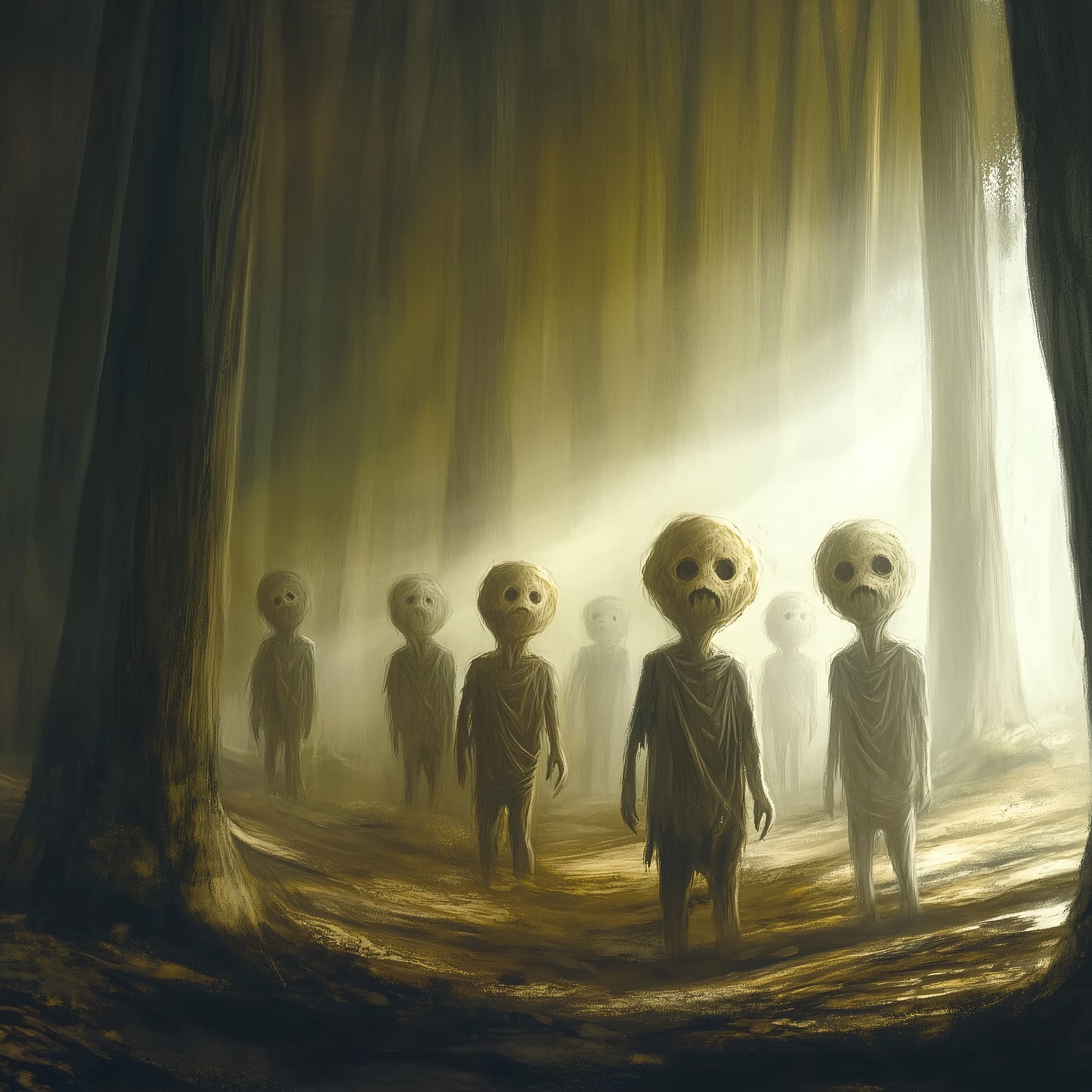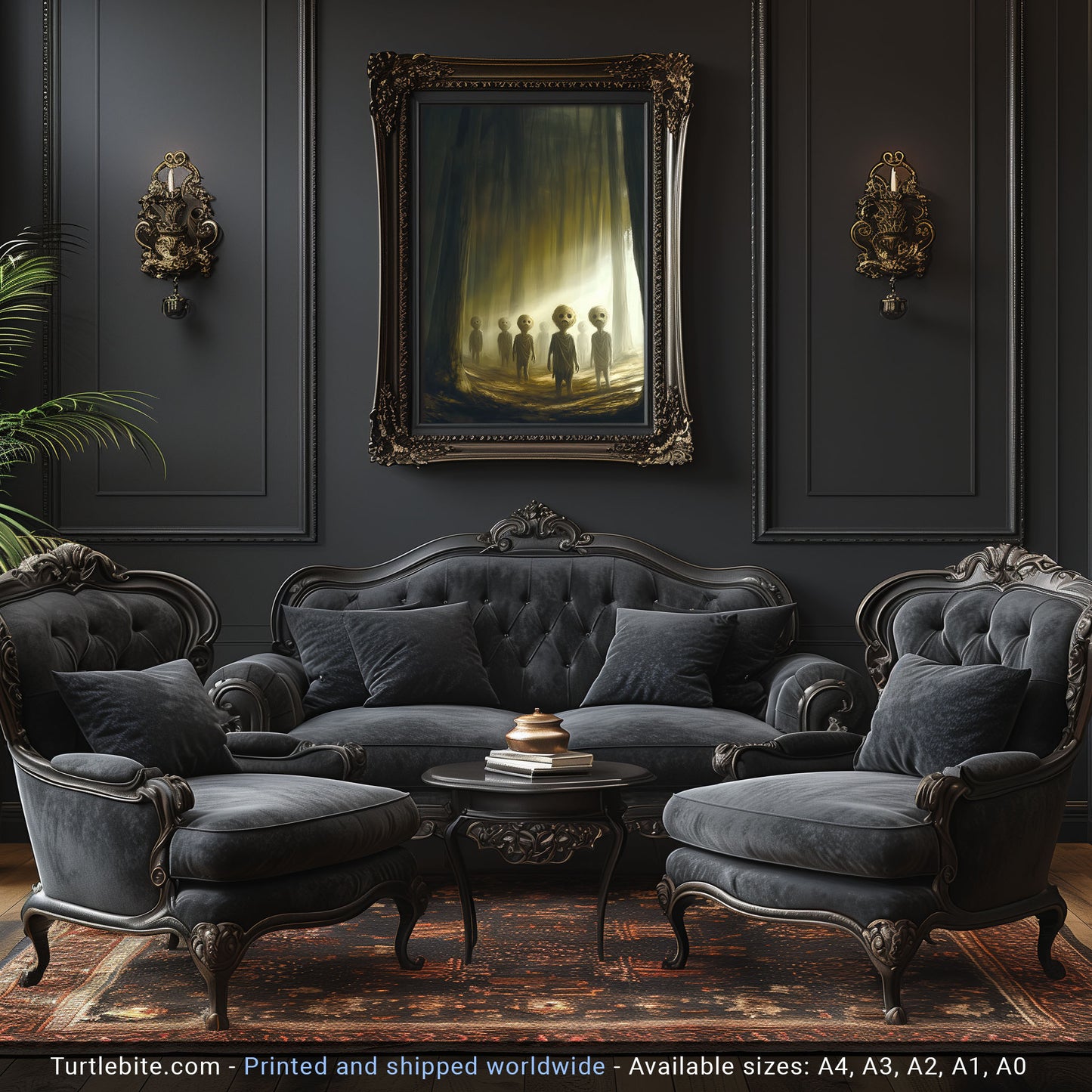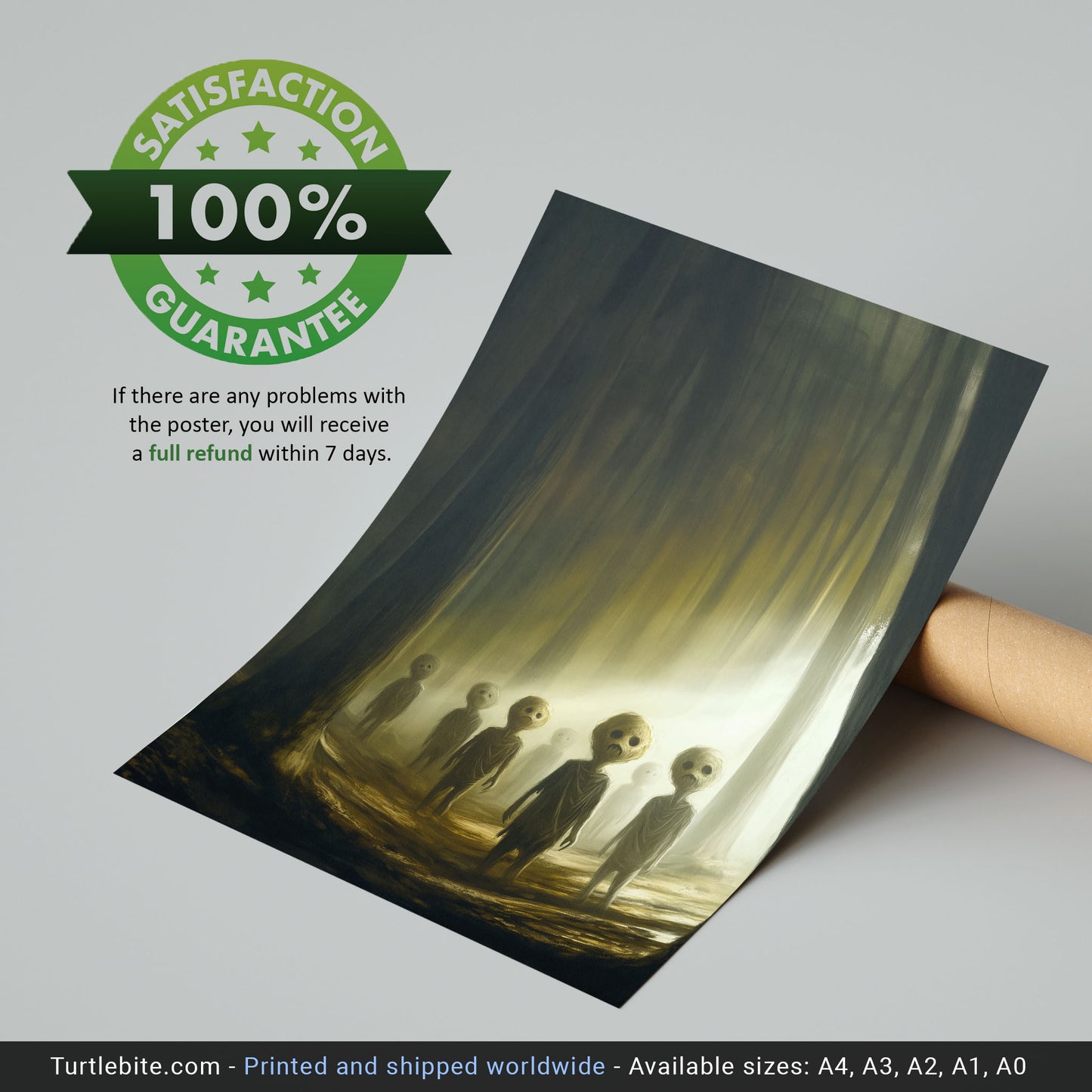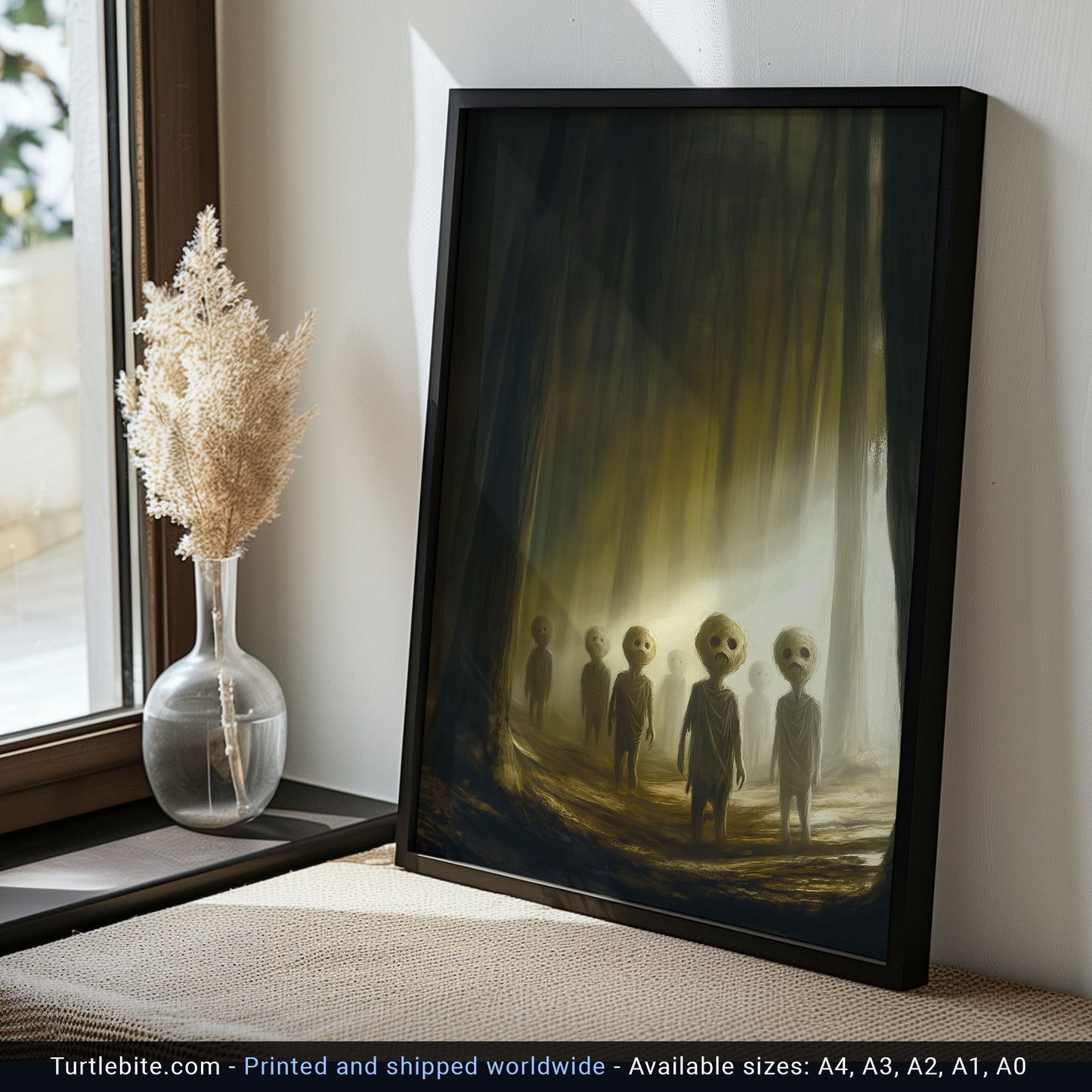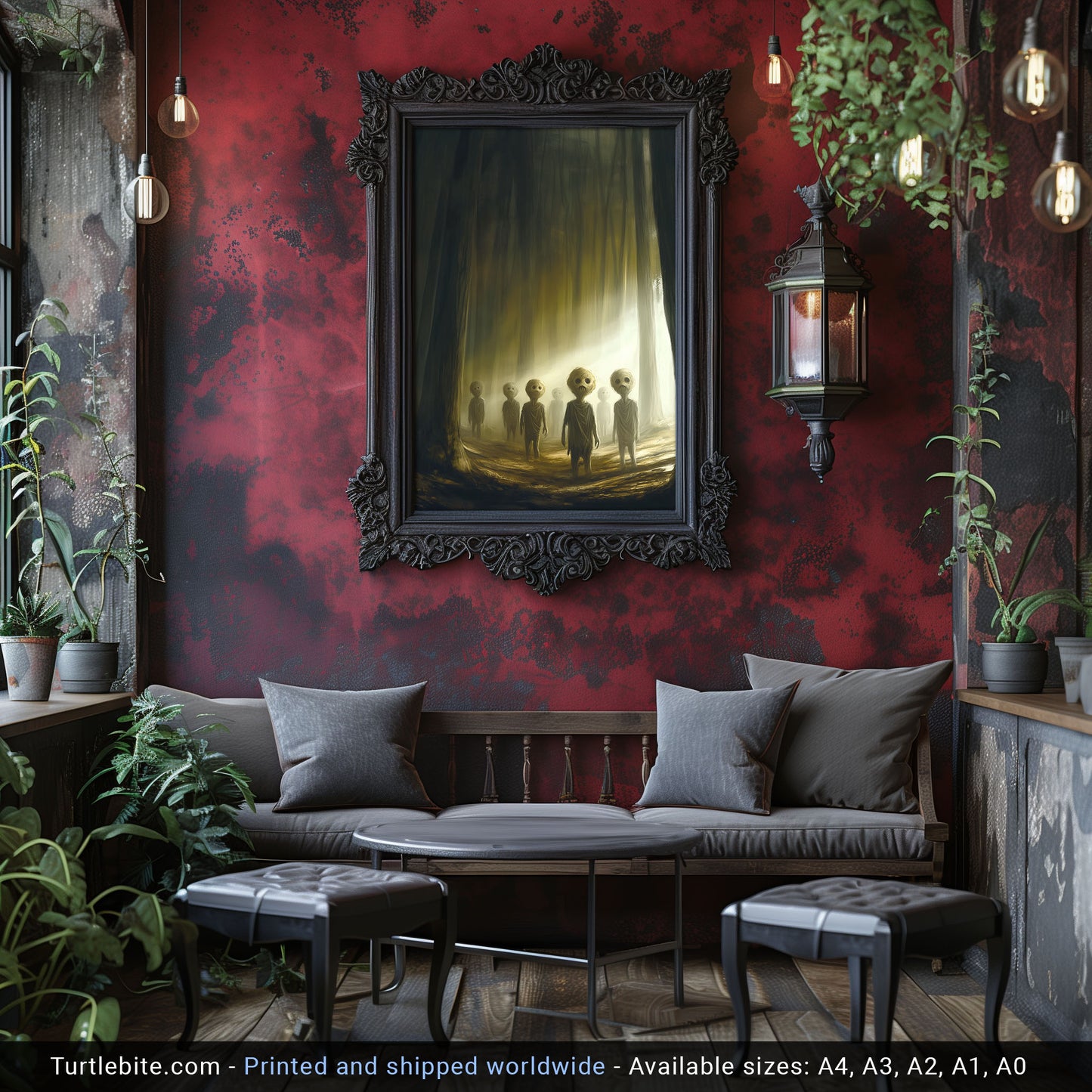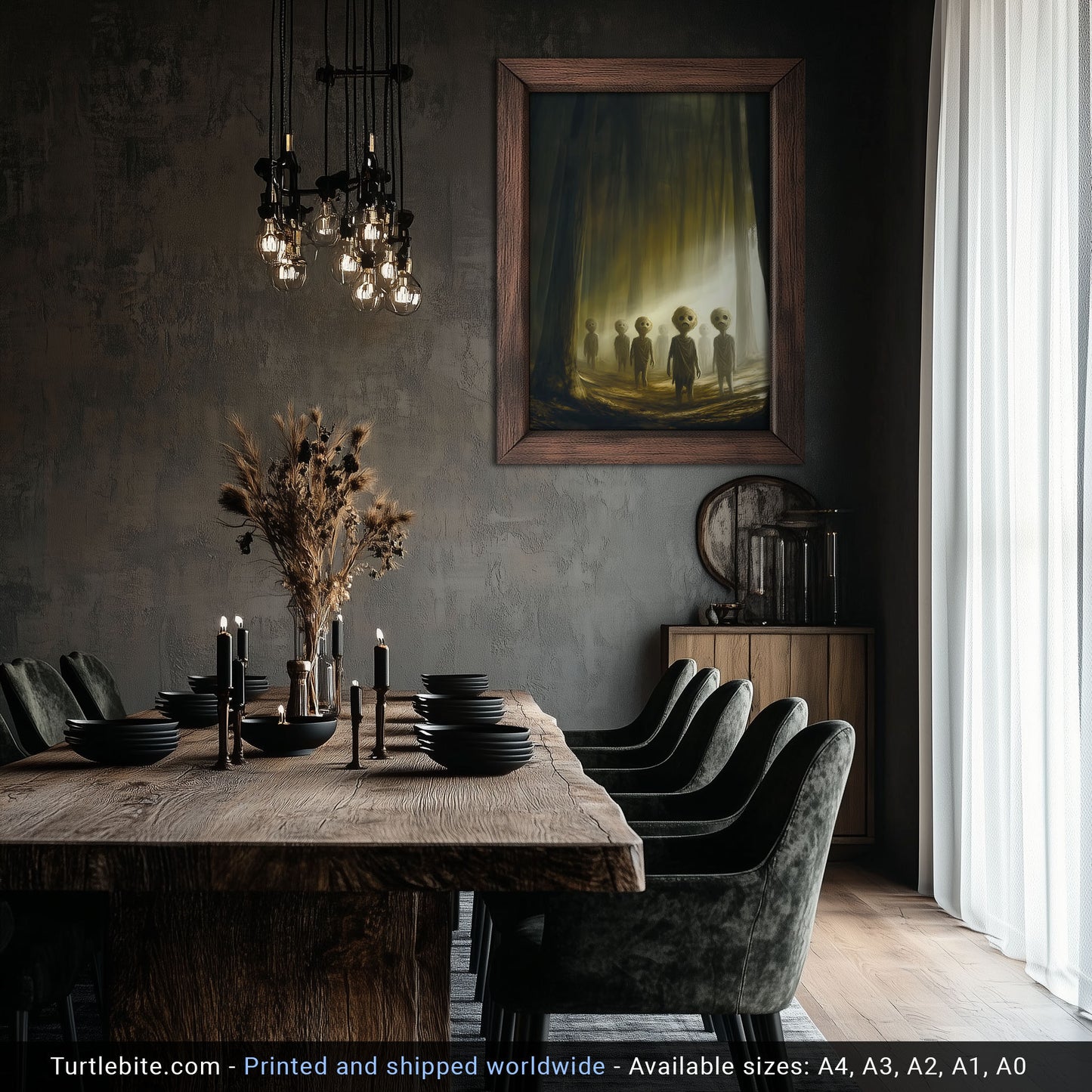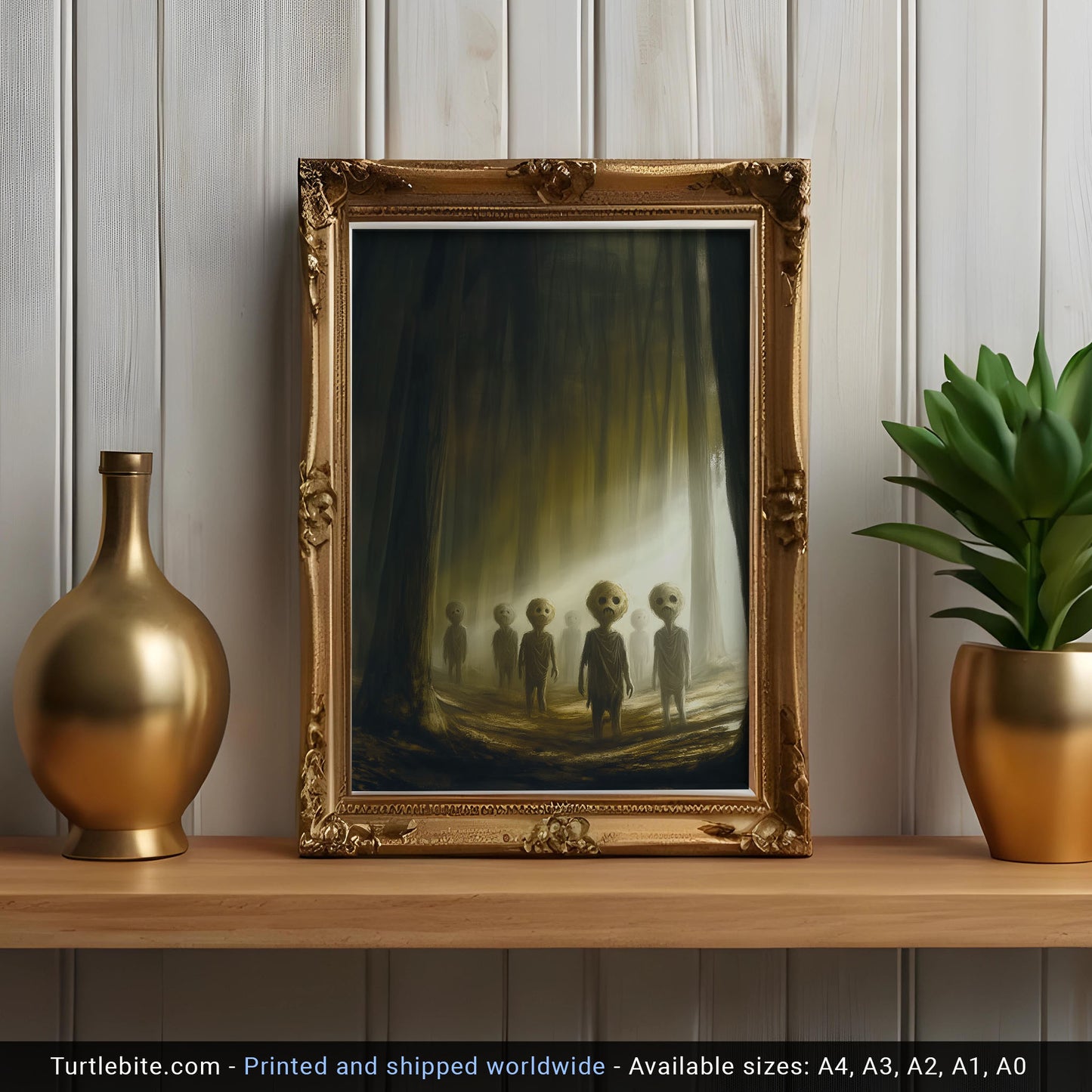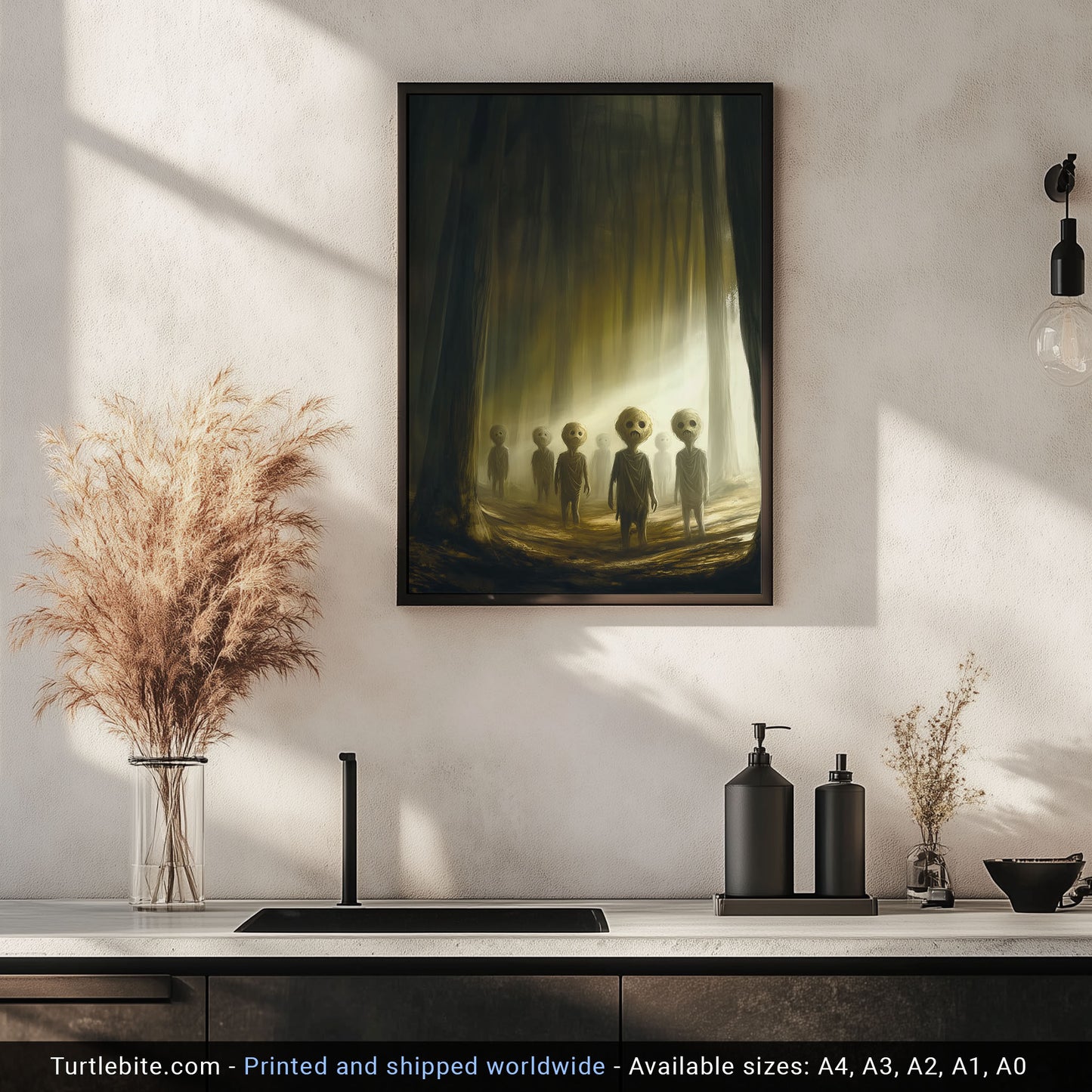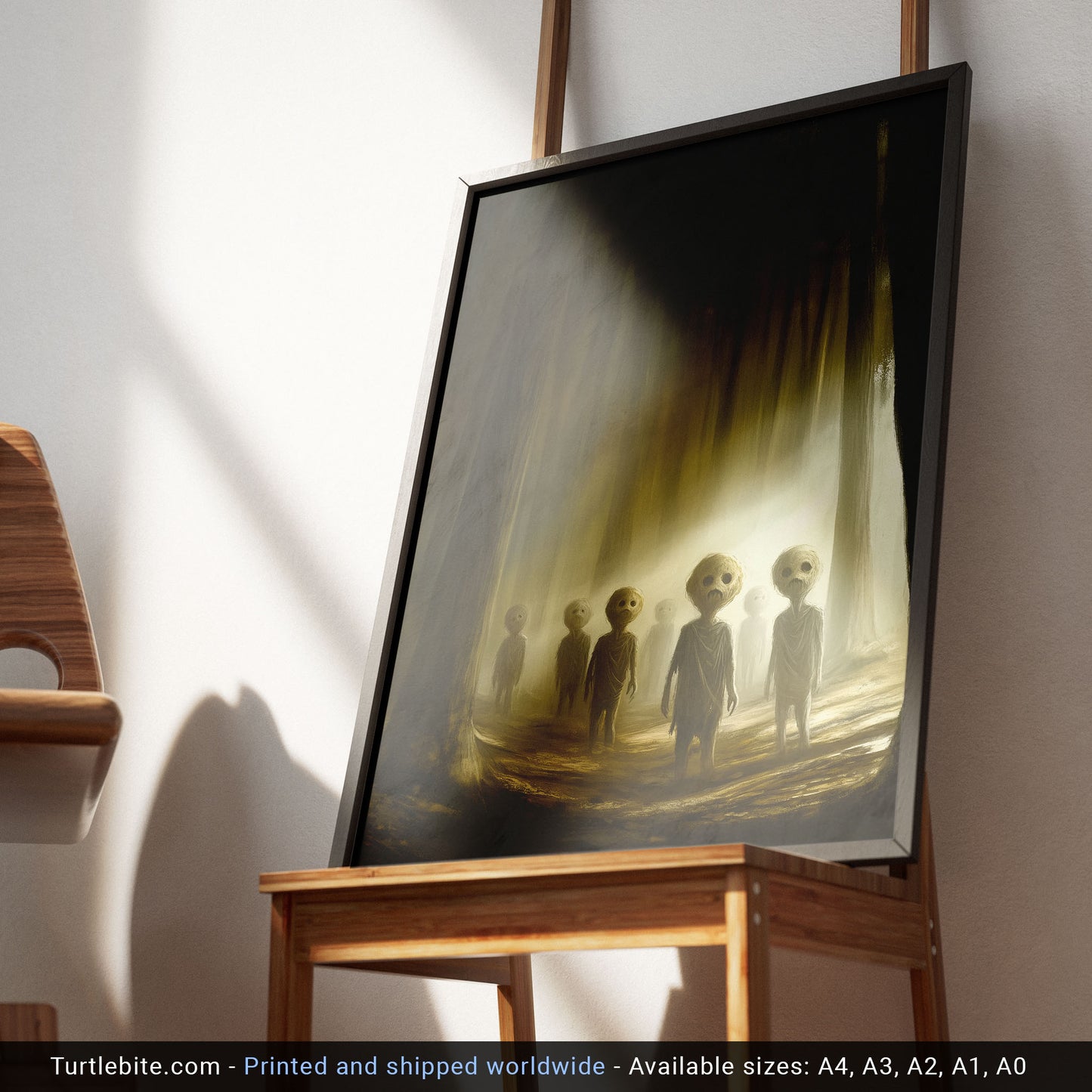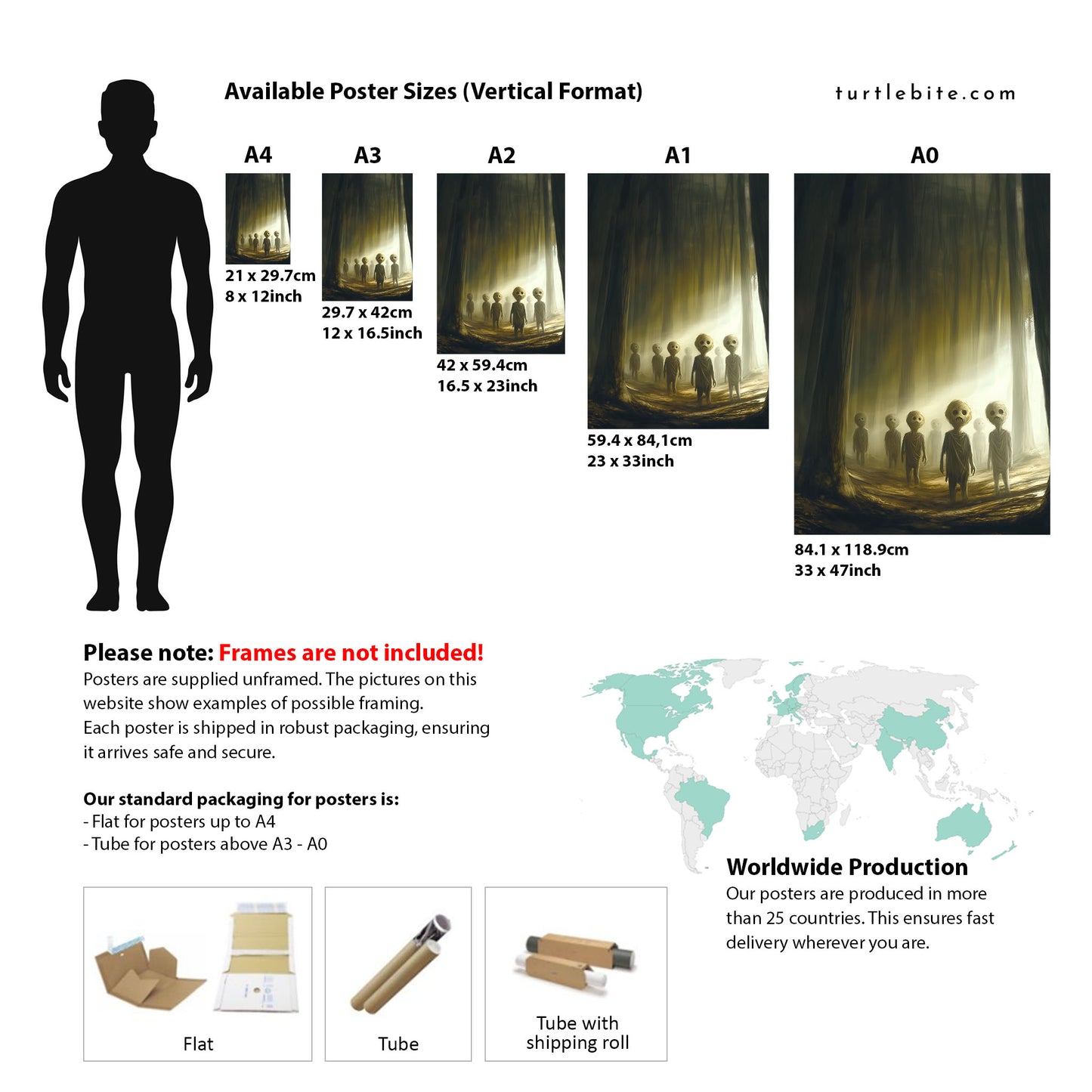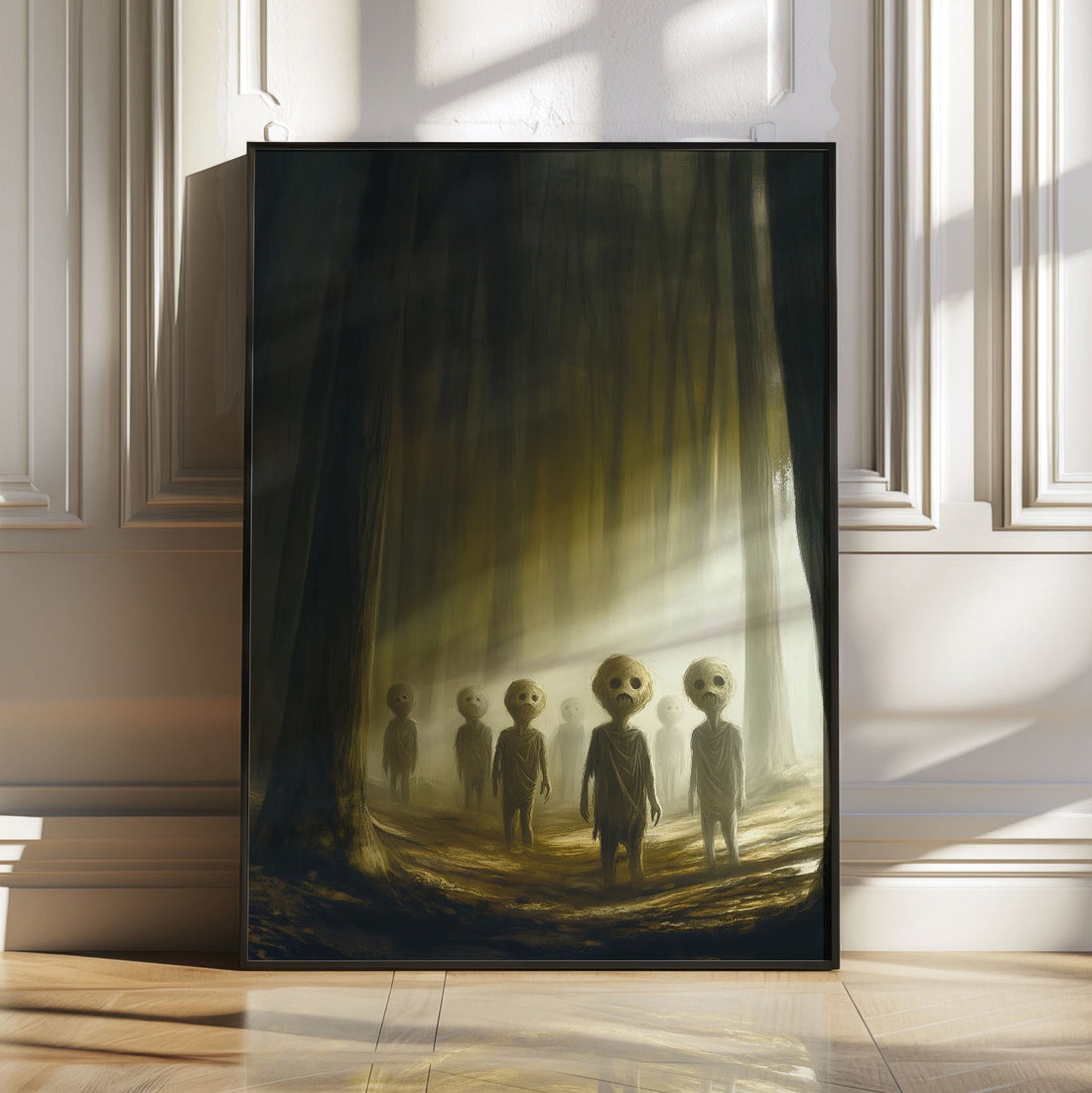
Into the Mist: The Haunting Allure of Surreal Forest Horror Art
ChristianShare
Where the Woods Whisper
There’s a reason forests haunt our imaginations. In folklore and nightmares alike, the woods symbolize the unknown - a place where light fades and things hide in the shadows. The illustration featured here taps directly into that primal fear. A group of children with oversized, hollow heads stands quietly in a fog-filled clearing, emerging like forgotten ghosts from some broken fairytale. The scene is equal parts beautiful and deeply disturbing.
This surreal horror painting draws from several visual traditions: dark fantasy, eerie folklore, and atmospheric storytelling. It’s a piece that doesn’t need motion to feel alive. With haunting composition and emotionally charged lighting, it grips the viewer with quiet intensity. Let’s explore how this creepy forest art uses composition, texture, and narrative suggestion to lodge itself into your memory - and maybe even your dreams.
The Power of Composition
The first thing that draws the eye in this piece is the group of spectral children. They aren’t cluttered or chaotic; they’re arranged with precise intent. Their spacing, posture, and orientation form a subtle triangular structure, giving the viewer a sense of depth and movement. This type of visual hierarchy is often found in classical art, guiding the gaze from foreground to background without confusion.
Each figure seems to be in mid-step, caught in that uncanny stillness between approach and retreat. This makes the illustration feel like a frozen moment - one where something is about to happen, but hasn’t yet. That pause is what triggers discomfort. We’re not just looking at the scene; we’re caught inside it. It’s that compositional magic that allows this eerie children artwork to transcend a flat surface and become an immersive experience.
The verticality of the background trees adds further dimension. Their towering presence contrasts with the small figures, exaggerating their vulnerability while also trapping them inside the frame like insects under glass. That tension - between movement and paralysis, between childlike innocence and lurking threat - is at the heart of what makes this horror digital illustration so compelling.
Light, Texture, and Color
A massive part of the image’s emotional resonance comes from its lighting. A diagonal beam of golden light cuts through the forest mist, illuminating the children while leaving the surrounding woods in shadow. This interplay creates a dramatic tension. Light becomes a character of its own - both revealing and concealing, like a flashlight sweeping across a dark room. It’s not comforting light. It’s the kind that makes you squint, that makes shadows stretch and crawl.
Color choices enhance the unease. The palette is dominated by muted greens, damp browns, and pale, washed-out yellows. The fog adds a chalky, grayish veil, softening the background and pushing our attention toward the harshly lit children. This combination of colors gives the piece a sense of aged decay - like something pulled from a forgotten attic or old photograph.
Texture also plays a subtle role. The children's straw-like hair and frayed garments evoke physicality, grounding these ghostly figures in a tactile reality. Meanwhile, the smooth gradients in the mist and sky evoke a dreamlike quality. The contrast between sharp and soft, real and unreal, contributes to the disorienting nature of the work.
This isn’t just spooky artwork - it’s an exercise in atmospheric control. Every detail, from shadow placement to the specific tint of gold in the light, is engineered to create an emotional response. The result is a dark fantasy wall art piece that’s equal parts visual and psychological.
Surrealism Meets Folklore
While the composition and lighting grab your attention, the real depth of this surreal horror painting lies in its conceptual layering. These aren’t just eerie children - they’re archetypes pulled from our collective unconscious. The visual cues suggest roots in folklore, particularly the American urban legend of the Melonheads. These mysterious beings are said to inhabit wooded areas in Ohio, Michigan, and Connecticut. Described as small, humanoid creatures with swollen heads and disturbing behavior, they’ve been the subject of whispers, roadside tales, and campfire stories for generations.
The figures in the artwork seem like distant cousins of these myths - more spectral and less feral, but no less unsettling. Their hollow expressions, uniform size, and uncanny presence blur the line between human and otherworldly. Whether or not the artist intended a direct connection to melonheads folklore, the similarities serve as a bridge between the image and deeper mythic currents.
This use of folklore within a surreal visual frame is what gives the artwork lasting power. It doesn’t explain itself - it invites interpretation. Are these children lost souls? Forest spirits? The remnants of some forgotten ritual? The ambiguity is deliberate, creating a participatory experience. Viewers aren’t just observers; they’re storytellers too, filling in gaps based on their own fears, memories, and cultural references.
In many ways, this painting echoes the works of surrealist artists like Remedios Varo or contemporary dark fantasy illustrators, who use dream logic to tell stories that bypass literalism. By combining unsettling imagery with folkloric archetypes, the piece becomes a kind of modern myth - a visual legend encoded in light and shadow.
Storytelling Without Words
One of the most remarkable aspects of this illustration is its ability to tell a story without a single line of text. It doesn’t need narration; it is narration. The viewer is dropped into the middle of a silent scene, and the quietness is deafening. You can almost hear the fog pressing in, the muffled crunch of leaves under small feet, the absence of birdsong.
This sense of silence enhances the eeriness. The children aren’t running or playing - they’re simply there. Still. Watching. Or maybe waiting. This ambiguity invites a host of interpretations. Are we looking at the aftermath of something terrible? Or the beginning of something worse?
Emotionally, the painting plays with a range of sensations: dread, wonder, nostalgia, and even a touch of grief. For some, the image may evoke lost childhood, fractured memories, or the strange emotional weight of dreams you can’t explain. It creates space for reflection, discomfort, and curiosity - all without uttering a word.
This is where the painting transcends its genre. Yes, it’s firmly rooted in creepy forest art, but it also belongs in the broader tradition of narrative illustration. Like a single frame of a larger story, it asks questions that linger. And in the world of visual storytelling, that’s one of the most powerful things an artwork can do.
Art as Atmosphere
Beyond its symbolic and emotional layers, this piece has strong potential as a decor element - especially for fans of the surreal, the gothic, and the unsettling. As a print, it would be a standout piece in a dark-themed gallery wall, an atmospheric hallway, or even a cozy but creepy reading nook. Its mood is specific, but its appeal is wide: horror fans, folklore nerds, surreal art collectors, and lovers of moody décor would all find resonance here.
What makes it especially versatile as dark fantasy wall art is its balance of beauty and unease. It’s not gory. It’s not jump-scare horror. Instead, it’s slow-burning, psychological, and visually rich. It creates a vibe, an atmosphere - a sense that the walls themselves might be remembering something.
For Halloween décor, gothic interiors, or thematic Airbnb spaces, this kind of art can serve as both a conversation starter and a mood-setter. And in a digital age where most visual content is scrolled past in seconds, this piece invites people to stop, stare, and feel.
Conclusion: A Stillness That Lingers
This artwork doesn’t shout. It whispers. And those whispers echo. With its eerie children, fog-drenched trees, and ambiguous light, it opens a door into a world that’s beautiful, unsettling, and strangely familiar. As both a visual experience and a symbolic narrative, it succeeds in being more than just a horror digital illustration - it becomes a mirror of the subconscious.
Whether you see haunted children, woodland spirits, or just a strange dream caught on canvas, one thing’s for sure: this painting stays with you. And in a world full of loud, fleeting images, that’s a rare and powerful kind of magic.


